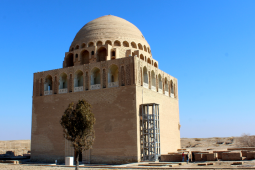Did You Know? The Importance of Paper Making Technology in Cultural Exchange along the Silk Roads
Layers of colorful traditional Samarkand paper © Noyan Yalcin/Shutterstock.comIn addition to silk there were a number of significant wares exchanged along the Silk Roads which had a great influence on the civilizations that encountered them. One important, but perhaps overlooked, trade ware which had a significant impact on the course of human history, is paper. The early trade of paper and perhaps more importantly the spread of paper making technologies along the regions encompassed by the Silk Roads greatly improved our collective abilities to record, store, and transport knowledge and information. As a convenient and affordable material for preserving writing, paper itself facilitated considerable cultural exchange.
In general, paper is made of interlaced cellulose fibres (material from a number of different possible plants), beaten in water and collected and dried on a screen. Although it was probably being made much earlier, and often from waste or leftover material, the first documented paper making comes from the eastern Han period (25 CE - 220 CE) where it was made with mulberry, bamboo, or rattan plant fibres. During this time refined hemp paper was also used, usually for religious texts, whilst paper made from mulberry was most often used for official documents and stationery (i.e. letters).
Paper was first transported to other regions by Buddhist monks who used it to record sutras and other writings. They carried paper to Japan and the Korean Peninsula as well as parts of Central Asia and the Indian Subcontinent. Paper making technology reached the Indian subcontinent in the mid-600s CE and local paper making centres were quickly formed. Reports by the Chinese Buddhist monk Xuanzang dated from 671 CE reveal that paper was already in widespread use in the parts of the Indian Subcontinent that he visited in the 670s CE. Religious practice played an important role in the spread of paper as it was a more efficient and easily transportable than parchment made from animal skin, and more durable than papyrus. Buddhist, Taoist, and Confucian texts were all produced on paper during this time. Paper was also an extremely valuable resource for merchants and traders who used this light and portable material as a means of recording their business. For example, a significant early paper find includes a mail bag from the 4th century CE containing letters and paper addressed to a merchant in Samarkand.
The Islamic world encountered paper for the first time sometime in the late 7th or early 8th century CE and quickly made use of paper production technology for administrative, literary, and scientific purposes. In 762 CE, when the Abbasid capital was relocated from Damascus to Baghdad, the bureaucratic demands of it and other Abbasid cities, lead to the introduction and quick diffusion of paper making across the Islamic world. Paper making in Baghdad began seriously in the late 8th century CE and the city became famed for its paper production with its own stationary market and a street reportedly lined with up to 100 different paper shops and book sellers. Indeed, paper making facilitated a flourishing in literary creativity and written culture which included works on geography, astronomy, medicine, and mathematics and led to a rise in popular literature being inexpensively copied and more easily available to the general public. Paper making was introduced to parts of Northern Africa and the Iberian Peninsula via the Abbasid civilization and later reached other regions of Europe, including what is today Italy, where production occurred in great volumes during the 13th century CE.
Furthermore, as paper moved along the Silk Roads the means of production would quickly follow, often employing different materials depending on what was most easily available in the new locale. This time between the introduction of paper and the introduction of paper making meant that where paper was first introduced to an area it often had to be reused multiple times leading to documents that had fulfilled a number of different purposes over their lifetime and which had often been written on in multiple different scripts and languages. For example, in Samarkand, before the city itself became a major centre of paper production, a local ruler was known to have re-used paper from China which had already been written on and had Chinese calligraphy on one side for administrative purposes. Although the spread of paper making technologies reduced the amount of paper that was actually traded across the Silk Roads, Chinese paper continued to be popular and traded widely as it was very valuable and considered to be of the highest quality. In the 10th century CE, the bibliographer and biographer Ibn al-Nadim reported meeting a bibliophile (a person who collected books) who avidly collected Chinese paper, having it transported thousands of miles.
It is easy to forget in the contemporary world that both paper and silk, two major trade exports of the Silk Roads, were once considered incredible new inventions produced from technologies and know-how that was transported along with the movement and interaction of people. Paper was both an exchanged element as well as a vector for further intercultural exchange as it allowed for knowledge to be transcribed and then transported over large distances and in its many production centres often sparked a flourishing in written culture.








